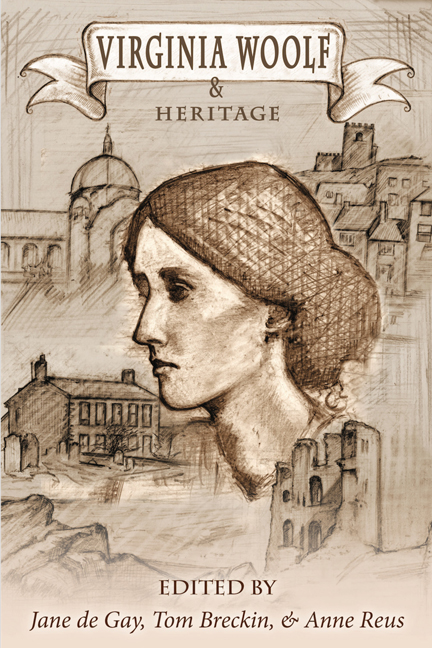Book contents
- Frontmatter
- Contents
- Introduction
- List of Abbreviations
- HERITAGE: A DEBATE
- HERITAGE, EDUCATION, AND MENTORING
- HERITAGE SPACES
- LITERARY AND CULTURAL HERITAGES
- QUEER PASTS
- MODERNISM AND HERITAGE
- WRITING LIVES AND HISTORIES
- The Play of Fact and Fiction in Virginia Stephen's “The Journal of Mistress Joan Martyn”
- “Writing the history of my own times”: Virginia Woolf and the Diary
- Heritage, Legacy, and the Life-Writing of Woolf and Rhys
- Life as Legacy: Truth, Fiction, and Fidelity of Representation in Biographical Novels Featuring Virginia Woolf
- From the Author to the Icon: A Heritage of Virginia Woolf in French Biographies and Biofictions
- Flights of Archival Imagination: Woolf 's Transcendent Materiality in Contemporary “Archive Fiction”
- WOOLF'S LEGACIES
- FINALE
- Notes on Contributors
Flights of Archival Imagination: Woolf 's Transcendent Materiality in Contemporary “Archive Fiction”
from WRITING LIVES AND HISTORIES
- Frontmatter
- Contents
- Introduction
- List of Abbreviations
- HERITAGE: A DEBATE
- HERITAGE, EDUCATION, AND MENTORING
- HERITAGE SPACES
- LITERARY AND CULTURAL HERITAGES
- QUEER PASTS
- MODERNISM AND HERITAGE
- WRITING LIVES AND HISTORIES
- The Play of Fact and Fiction in Virginia Stephen's “The Journal of Mistress Joan Martyn”
- “Writing the history of my own times”: Virginia Woolf and the Diary
- Heritage, Legacy, and the Life-Writing of Woolf and Rhys
- Life as Legacy: Truth, Fiction, and Fidelity of Representation in Biographical Novels Featuring Virginia Woolf
- From the Author to the Icon: A Heritage of Virginia Woolf in French Biographies and Biofictions
- Flights of Archival Imagination: Woolf 's Transcendent Materiality in Contemporary “Archive Fiction”
- WOOLF'S LEGACIES
- FINALE
- Notes on Contributors
Summary
Resurrecting the dead archive inspired Virginia Woolf with a mixture of disgust and delight. She was viscerally horrified yet strangely fascinated by the patronizing display of the Brontë relics at Haworth early in her career as “a pallid and inanimate collection of objects” (E1 7). By 1925, in “The Lives of the Obscure,” books in a library are equated to dead bodies who “sleep on the walls” and she asks that since “[t] heir backs are flaking off; their titles are vanished. Why disturb their sleep? Why reopen those peaceful graves?” (CR1 146). Yet the researcher is styled as the liberator of history who “likes romantically to feel oneself a deliverer advancing with lights across the waste of years to the rescue of some stranded ghost” (146–147). And the dead respond: “Possibly they hear one coming. They shuffle, they preen, they bridle. Old secrets well up to their lips. The divine relief of communication will soon be theirs” (147). Here, banal materiality has the power to produce flights of what may be termed archival imagination. This dichotomy of course relates to Woolf's central concern with the tension between imagination and mundane objects exemplified in short stories such as “The Mark on the Wall” (CSF 77–83). In this paper, I focus on the twenty-first century legacy of Woolf's archival imagination: a productive tension between a horror of tangibly dead matter and a desire to access the intangible life that material relics store within them, a conflicting desire to both resurrect the dead in imagination and to righteously let them lie inert; a pull between “granite and rainbow”—fact and imagination (Selected Essays 100).
This paper concerns two contemporary attempts to creatively channel the voice of the archive in a Woolfian mode, both published in 2014: Maggie Gee's Virginia Woolf in Manhattan and Hermione Eyre's Viper Wine. Virginia Woolf in Manhattan conducts an archival resurrection, transposing Woolf into the present day of a fictional author via a mystical communion with archival relics, not unlike that found in “The Lives of the Obscure.” I also want to make the claim that Woolfian influence is evident in archival and biofictional texts that do not feature her as a character, but which visibly descend from her prescriptions for the creative treatment of archives.
- Type
- Chapter
- Information
- Virginia Woolf and Heritage , pp. 223 - 228Publisher: Liverpool University PressPrint publication year: 2017



